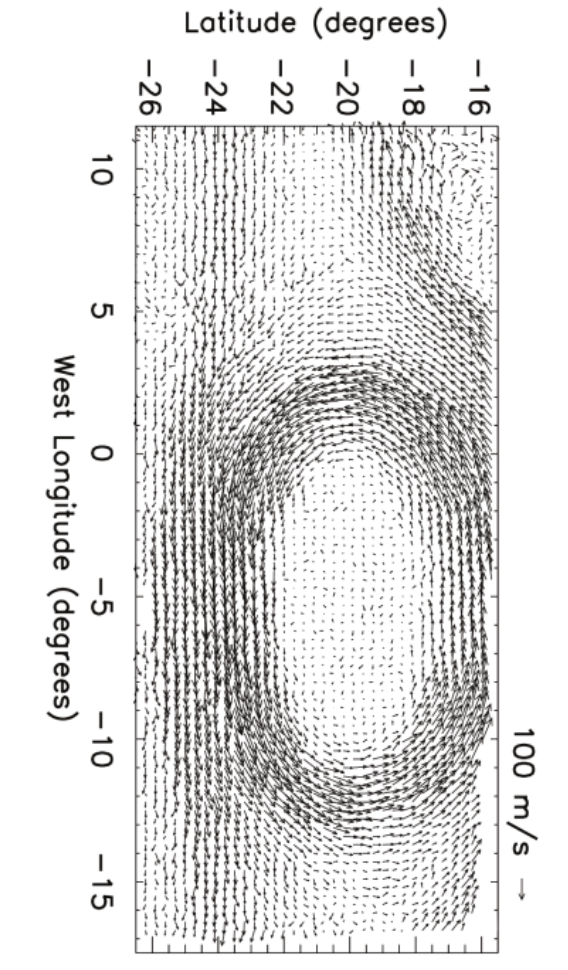2020年GeCAA理论第8题-木星大红斑
In the following problem the fluid mechanics of Jupiter’s Great Red Spot (GRS) is studied based on the velocity field data. The diagram on the next page shows a map of relative velocity for GRS and the surrounding region. The arrows are oriented and scaled as per the directions and magnitudes of winds at different points.
Due to the combined effects of gravity and rotation, Jupiter is slightly flattened at its poles. The equation of a spheroid approximating for the shape of Jupiter can be stated as:
$$\frac{x^{2} +y^{2} }{R_{e}^{2} } +\frac{z^{2} }{R_{p}^{2}} =1$$
where $$R_{e}=7.15\times 10^{7} m$$ is the equatorial radius of Jupiter, and $$R_{p}=6.69\times 10^{7}m$$ the polar radius. The radii of curvature of this spheroid in any direction can be calculated by the following equations $$(\epsilon =\frac{R_{e}}{R_{p}} )$$:
$$r(\phi )=R_{e} (1+\epsilon^{-2}\tan ^{2}\phi)^{-\frac{1}{2} }$$
$$R(\phi )=R_{e}\epsilon^{-2}(\frac{r(\phi )}{R_{e}\cos\phi } )^{3} $$
where $$r$$ and $$R$$ are the zonal (aka in the zone of a particular latitude) and meridional (aka longitudinal) radii of curvature, respectively, as a function of planetographic latitude $$\phi $$. The sidereal rotation period of Jupiter is $$P=3.57\times 10^{4}s $$.
(a) (4 points) Calculate the zonal and meridional radii values ($$\bar{r}$$ and $$\bar{R}$$ respectively) at the location of the centre of the GRS.
(b) (5 points) Estimate the eccentricity of the GRS.
(c) (6 points) ’Vorticity’ at any point is a measure of local spinning of the fluid as measured by an observer situated in the reference frame of the fluid. Mathematically, it is calculated as ’curl’ (vector derivative product) of the velocity field. In this case, the average relative vorticity may be estimated by the equation:
$$\xi =\frac{V_{w} L_{GRS} }{A_{GRS} } $$
where $$V_{w}$$ is the maximum value of winds as per the velocity field, $$L_{GRS}$$ is the length of the circumference of the GRS and $$A_{GRS}$$ is the area of the GRS.
Estimate average relative vorticity of the GRS.Hint: The circumference of an ellipse is well approximated by an average of circumferences of the corresponding auxiliary and minor circles.
(d) (2 points) Find the absolute vorticity $$\xi _{a} =(\xi +f)$$ by adding the Coriolis paramete
$$f=2\Omega \sin \phi $$
where $$\Omega$$ is the angular velocity of the Jupiter (due to axial rotation) and is the appropriate latitude.
(e) (1 point) If the absolute vorticity has the same sign as the latitude, we call the storm a ‘cyclonic storm’. If they have opposite signs, the system is ‘anticyclonic’. Is the GRS cyclonic or anticyclonic?
(f) (12 points) Imagine that the GRS moves to another latitude $$\phi _{1}$$ , where the absolute vorticity changes the sign (changes from anti-cyclonic to cyclonic or vice versa). Assuming minimum possible displacement of the GRS, at what value of $$\phi _{1}$$ do we expect this change? In your analysis, assume that the GRS at the new location would occupy the same angular span in latitude, as well as have the same wind velocities and eccentricity as the original.
